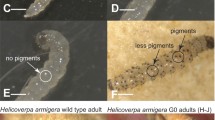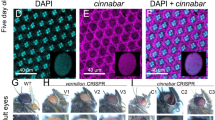Summary
Black cells (Bc, 2-80.6±) mutant larvae ofDrosophila melanogaster have pigmented cells in the hemolymph and lymph glands. In this report we present evidence that these melanized cells are a mutant form of the crystal cells, a type of larval hemocyte with characteristic paracrystalline inclusions.Bc larvae lack crystal cells. Furthermore, the distribution pattern of black cells inBc larvae parallels that of experimentally-blackened crystal cells in normal larvae (phenocopy).InBc/Bc zygotes black cells appear during mid embryonic development but inBc +/Bc zygotes pigmented cells are not found until late in the first larval instar.Crystal cells are present in the heterozygous larvae until this time, and paracrystalline inclusions can be seen in some of the cells undergoing melanization in these larvae.The rate of phenol oxidase activity inBc +/Bc larval cell-free extracts is less than half that ofBc +/Bc +extracts whereas enzyme activity is undetectable inBc/Bc larvae. We propose that theBc +gene product is required for maintaining the integrity of the paracrystalline inclusions; inBc/Bc larvae either the product is absent or nonfunctional so an effective contact between substrate and enzyme results in melanization of the cells.Phenol oxidase itself is either destroyed or consumed in the melanization process accounting for the absence of enzyme activity inBc/Bc larvae. These studies confirm that the crystal cells store phenolic substrates and are the source of the hemolymph phenol oxidase activity in the larva ofD. melanogaster.
Similar content being viewed by others
References
Grell EH (1969)Bc: Black cells. Drosophila Inform Serv 44:46
Hackman RH (1974) Chemistry of the insect cuticle. In: Rockstein M (ed) The Physiology of insecta, 2nd edn, vol VI Academic Press, New York, London
Harper RA, Armstrong FB (1974) Alkaline phosphatase ofDrosophila melanogaster. III. Tyrosine-0-phosphate as substrate. Biochem Genet 11:177–180
Lewis HW (1960) Genetic control of dopa oxidase activity inDrosophila melanogaster. I. Analysis of wild type, sable, suppressor of-sable, and suppressed sable strains. Genetics 45:1217–1231
Lindsley DL, Grell EH (1967) Genetic variations ofDrosophila melanogaster. Carnegie Inst Washington Publ No 627
Lunan KD, Mitchell HK (1969) The metabolism of tyrosine-0-phosphate inDrosophila. Arch Biochem Biophys 132:450
Mitchell HK (1966) Phenol oxidases andDrosophila development J Insect Physiol 12:755–765
Ohnishi E (1954) Tyrosinase inDrosophila virilis. Annot Zool Jpn 27:33–39
Peeples EE, Geisler A, Whitcraft CJ, Oliver CP (1969) Comparative studies of phenol oxidase activity during pupal development of three lozenge mutants (lz s, lz, lzk)ofDrosophila melanogaster. Genetics 62:161–170
Poulson DF (1950) Histogenesis, organogenesis, and differentiation in the embryo ofDrosophila melanogaster meigen. In: Demerec M (ed) Biology ofDrosophila. John Wiley & Sons, Inc., New York
Richards AG (1978) The chemistry of insect cuticle. In: Rockstein M (ed) Biochemistry of insects. Academic Press, New York, London
Rizki TM (1957a) Alterations in the hemocyte population ofDrosophila melanogaster. J Morphol 100:437–458
Rizki TM (1957b) Tumor formation in relation to metamorphosis inDrosophila melanogaster. J Morphol 100:459–472
Rizki TM (1978) The circulatory system and associated cells and tissues. In: Ashburner M, Wright TRF (eds) The genetics and biology of Drosophila, vol 2b. Academic Press, New York, London
Rizki TM, Rizki RM (1959) Functional significance of the crystal cells in the larva ofDrosophila melanogaster. J Biophys Biochem Cytol 5:235–240
Seybold WD, Meltzer PS, Mitchell HK (1975) Phenol oxidase activation inDrosophila: A cascade of reactions. Biochem Genet 13:85–108
Warner CK, Grell EH, Jacobson KB (1974) Phenol oxidase activity and the lozenge locus ofDrosophila melanogaster. Biochem Genet 11:359–365
Yamazaki HI (1969) The cuticular phenoloxidase inDrosophila virilis. J Insect Physiol 15:2203–2211
Yamazaki HI, Ohnishi E (1968) Phenol oxidase activity and phenotypic expression of the melanotic tumor straintu ginDrosophila melanogaster. Genetics 59:237–243
Author information
Authors and Affiliations
Rights and permissions
About this article
Cite this article
Rizki, T.M., Rizki, R.M. & Grell, E.H. A mutant affecting the crystal cells inDrosophila melanogaster . Wilhelm Roux' Archiv 188, 91–99 (1980). https://doi.org/10.1007/BF00848799
Received:
Accepted:
Issue Date:
DOI: https://doi.org/10.1007/BF00848799




